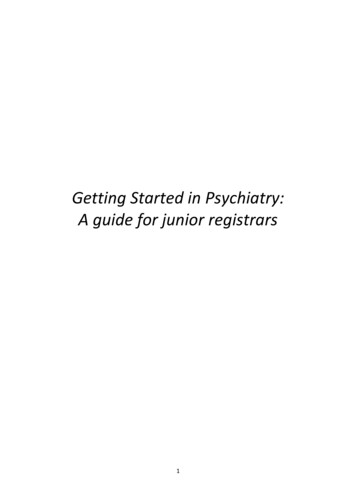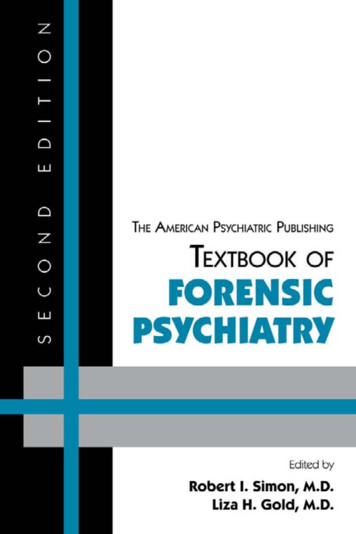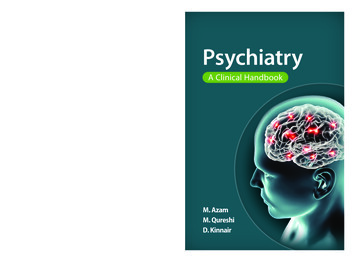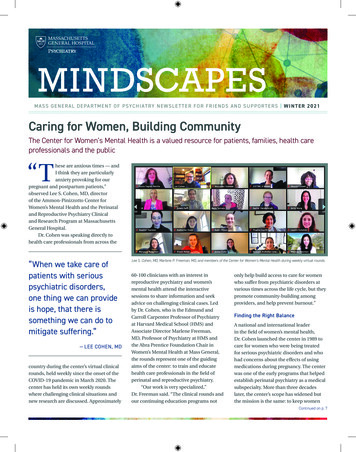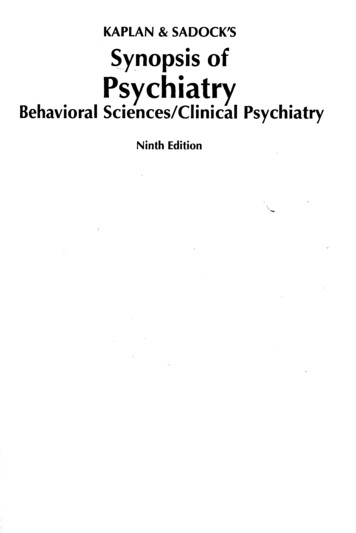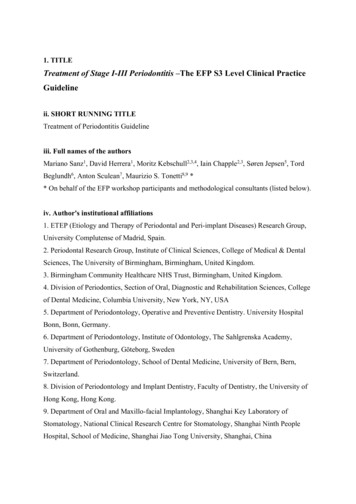
Transcription
European Psychiatrywww.cambridge.org/epaResearch ArticleCite this article: Fürtjes S, Seidel M, Diestel S,Wolff M, King JA, Hellerhoff I, Bernadoni F,Gramatke K, Goschke T, Roessner V, Ehrlich S(2022). Real-life self-control conflicts inanorexia nervosa: An ecological momentaryassessment investigation. EuropeanPsychiatry, 65(1), e39, ved: 01 March 2022Revised: 01 June 2022Accepted: 01 June 2022Keywords:Anorexia nervosa; eating disorders; ecologicalmomentary assessment; self-control; selfcontrol conflictAuthor for correspondence:*Stefan Ehrlich,E-mail: transden.lab@uniklinikum-dresden.deReal-life self-control conflicts in anorexianervosa: An ecological momentary assessmentinvestigationSophia Fürtjes1,2 , Maria Seidel1 , Stefan Diestel3 , Max Wolff4,5 ,Joseph A. King1, Inger Hellerhoff1,6Thomas Goschke7, Veit Roessner6, Fabio Bernadoni1, Katrin Gramatke6,and Stefan Ehrlich1,6*1Translational Developmental Neuroscience Section, Division of Psychological and Social Medicine and DevelopmentalNeuroscience, Faculty of Medicine, Technische Universität Dresden, Dresden, Germany; 2Department of Psychology,Technische Universität Dresden, Dresden, Germany; 3Schumpeter School of Business and Economics, Faculty ofEconomy, University of Wuppertal, Wuppertal, Germany; 4MIND Foundation, Berlin, Germany; 5Department ofPsychiatry and Psychotherapy, Charité Universitätsmedizin Berlin, Campus Charité Mitte, Berlin, Germany; 6EatingDisorder Research and Treatment Center, Department of Child and Adolescent Psychiatry, Faculty of Medicine,Technische Universität Dresden, Dresden, Germany and 7Department of Psychology, Technische Universität Dresden,Dresden, GermanyAbstractBackground. Individuals with anorexia nervosa (AN) are often thought to show heightened selfcontrol and increased ability to inhibit desires. In addition to inhibitory self-control, antecedentfocused strategies (e.g., cognitive reconstrual—the re-evaluation of tempting situations) mightcontribute to disorder maintenance and enable disorder-typical, maladaptive behaviors.Methods. Over a period of 14 days, 40 acutely underweight young female patients with anorexianervosa (AN) and 40 healthy control (HC) participants reported their affect and behavior in selfcontrol situations via ecological momentary assessment during inpatient treatment (AN) andeveryday life (HC). Data were analyzed via hierarchical analyses (linear and logistic modeling).Results. Conflict strength had a significantly lower impact on self-control success in ANcompared to HC. While AN and HC did not generally differ in the number or strength ofself-control conflicts or in the percentage of self-control success, AN reported self-controlledbehavior to be less dependent on conflict strength.Conclusions. While patients with AN were not generally more successful at self-control, theyappeared to resolve self-control conflicts more effectively. These findings suggest that themagnitude of self-control conflicts has comparatively little impact on individuals with AN,possibly due to the use of antecedent-focused strategies. If confirmed, cognitive-behavioraltherapy might focus on and help patients to exploit these alternative self-control strategies in thebattle against their illness.Introduction The Author(s), 2022. Published by CambridgeUniversity Press on behalf of the EuropeanPsychiatric Association. This is an Open Accessarticle, distributed under the terms of theCreative Commons Attribution licence (http://creativecommons.org/licenses/by/4.0), whichpermits unrestricted re-use, distribution andreproduction, provided the original article isproperly cited.Anorexia nervosa (AN) is characterized by extreme restriction of food intake and rigidbehaviors that serve to control many aspects of daily life related to eating and weight gain[1, 2]. Individuals with AN are often thought to exercise excessive self-control to override foodrelated needs and desires in their relentless pursuit of thinness [3, 4]. However, little is knownabout how patients with AN might actually accomplish the high levels of control conceivablyrequired to reach and maintain severely low bodyweight or how they experience self-controlsituations in everyday life.Currently, influential theories propose that high self-control is achieved via effortfulinhibition of prepotent behavioral impulses and resisting desires which interfere with personalgoals [5]. Indeed, previous research has shown that inhibitory control is associated with lessconsumption of fatty foods and snacks [6–8], higher resistance to food desires, and successfulweight loss [9]. Furthermore, a reduced activation in brain areas involved in inhibitory control(e.g., the right inferior frontal gyrus) has been shown to predict daily self-control failures,including food consumption [10, 11]. A plausible explanation for seemingly successful selfcontrolled behavior in AN might therefore be an unusually high capacity for inhibitory selfcontrol, which enables resistance to temptations in the pursuit of disorder-typical goals (e.g.,body/shape). This line of reasoning is supported by neuroimaging research suggesting thatindividuals with a history of AN show increased cognitive control (i.e., processes that organizebehavior in a self-controlled goal-directed manner [12]) during reward processing [13], andthat inhibitory control appears to require less effort in patients with AN [14–16]. Followingthis rationale, AN patients should have higher rates of success in overcoming 9 Published online by Cambridge University Press
Sophia Fürtjes et al.2self-control situations (i.e., resisting temptations such as watchingTV instead of doing homework) in everyday life compared withhealthy controls (HCs).However, successful self-control might not be achieved solelyvia reactive resistance and inhibition of desires. Furthermore,these strategies may actually often be ineffective [17]. Behavioralstrategies that proactively help to avoid tempting situations (e.g.,environmental structuring or situation selection) or cognitivestrategies such as, for example, goal priming (i.e., tempting cuesare conditioned to activate self-control goals) and reconstrual(i.e., tempting cues are re-evaluated to be less desirable, similarto reappraisal processes) most likely also play a role in self-controlby decreasing the necessity of effortful inhibition [18–22]. Theseso-called antecedent self-control strategies (especially reconstrual/reappraisal [20]), which have previously been mainly discussed in the context of emotion regulation [23], have recentlygained interest [21]. Preliminary support suggesting that antecedent-focused self-control strategies are relevant to AN can bedrawn from a study demonstrating that individuals with restrictive eating patterns experience less conflict when choosing thehealthier of two food options (which might reflect cognitiveprocesses such as reconstrual or goal priming [24]). If this canaccount for heightened self-control in AN patients, we wouldexpect fewer and/or weaker self-control conflicts in everyday liferelative to HC.The present study investigated self-control processes in theeveryday lives of patients with AN via ecological momentaryassessment (EMA) [25], involving data acquisition via smartphoneseveral times a day over a period of several days. By assessing thefrequency of conflicting self-control situations, the strength of selfcontrol conflicts and underlying desires, and the rate of successfulself-control situations in patients with AN compared to HC, weaimed to elucidate actual self-control behavior in AN, outside oflaboratory settings.MethodsParticipantsThe initial sample consisted of 42 females with acute AN accordingto DSM-5 and 57 HCs (age range: 12.9–27.3 years). HCs wereselectively recruited to minimize age differences between the twogroups. To further optimize group comparisons and control forpossible developmental effects, we implemented a pairwise matching algorithm [26]. The final sample consisted of 40 participants pergroup, which despite this procedure showed a small but significantage difference (Table 1). Diagnosis of AN was established using theexpert form of the semi-structured interview for eating disorders(SIAB-EX) [27] and required a body mass index (BMI) below the10th age percentile (if younger than 15.5 years) or below 17.5 kg/m²(if older than 15.5 years). AN patients were recruited within 96 h ofadmission to an inpatient treatment program at a university childand adolescent psychiatric department, which included individual,group, and family therapy. HCs had to be of normal weight,eumenorrheic, and without any history of psychiatric illness(assessed via the Mini International Neuropsychiatric Interviewfor Children and Adolescents [28]. All HCs were also assessed withthe SIAB-EX and excluded if they showed any abnormal eatingbehavior. All participants were also interviewed with our own semistructured interview to assess exclusion criteria (e.g., substanceabuse and neurological conditions). The recruitment procedurehttps://doi.org/10.1192/j.eurpsy.2022.29 Published online by Cambridge University Presswas highly similar to our previous studies [29, 30] (see also theSupplementary Material [SM]).Materials and procedureEMA assessmentSelf-control was assessed via a short questionnaire based on theworks of Hofmann et al. [31] and adapted from Wolff et al.[32]. An overview of the structure of the questionnaire and theassessed variables is visualized in Figure 1. At each prompt,participants were first asked whether or not they had experienceda situation in which they felt a desire to enact a certain behavior(since the last alarm) and also had the opportunity to do so (binaryvariable; yes/no). If this was the case, they were asked to select thedesire category by choosing 1 out of 17 domains (e.g., eating,exercise, and watching TV; see the SM) and to indicate the desirestrength on a scale from one (very weak) to seven (very strong).The next question assessed conflict (binary variable; yes/no) byasking whether or not participants had thought it would be betternot to enact the desired behavior (i.e., if there was a reason toengage in self-control instead of simply enacting the desiredbehavior). Whenever participants reported a conflict, conflictstrength was assessed on a scale from one (very weak) to seven(very strong) and participants were asked whether they had triedto resist the desire (resistance, binary variable; yes/no). Lastly,success (binary variable; yes/no) versus failure was assessed via thequestion whether participants had succeeded in not enacting thedesired behavior.Research has shown that self-control failure is often followed bynegative affect in patients with AN, whereas controlled behaviormay lead to positive affect. Alternative views exists as well, indicating that the relationship between failed self-control and affect inAN may be very nuanced [33]. Therefore, we also assessed affectivestates via a modified version of the Multidimensional Mood Questionnaire (MDMQ) [30, 34, 35]. Six items were adapted to assesscalmness, energetic arousal, and valence of affect via visual analoguescales ranging from one to seven with opposite words as anchors(e.g., agitated calm).ProcedureBefore EMA, participants were interviewed, weighed, and measured. BMI and an age-adapted body mass index standarddeviation score (BMI-SDS) [36, 37] were calculated. Participantsalso completed questionnaires to assess eating disorder(ED) symptoms (Eating Disorder Inventory-2 [EDI-2]) [38]and the depressive symptoms (Beck Depression Inventory-II[BDI-II]) [39]. Participants were given a detailed tutorial onhow to handle the study smartphone and fill out the EMAquestionnaires. Afterward, they received a study smartphonewith the preinstalled app for data collection (xs.movisens)[40]. EMA assessment started the day following the tutorial.HCs completed the assessment for 7 days of their everyday life,and AN for 7 days of their daily routine during inpatient treatment. Participants were prompted eight times a day by an alarmto fill out the questionnaire. The alarms were semi-randomizedduring a 14-h period (individually adapted to fit different dailyroutines), allowing for data assessment over the course of the fullday. After EMA assessment was completed, participants receivedmonetary compensation in accordance with compliance(i.e., number of completed questionnaires). The study procedurewas approved by the local ethics committee, and all participants
European Psychiatry3Table 1. Sample characteristics and descriptive statistics.HC [M SD]AN [M SD]t (p)Age17.20 2.7915.90 1.472.66b (0.01)BMI21.17 2.2714.41 1.4515.89b (0.00)BMI-SDS0.03 0.633.40 1.1016.87b (0.00)BDI-II5.08 5.5826.05 8.5912.95b (0.00)EDI-2132.84 25.44218.11 34.5212.58b (0.00)0.69 0.180.82 0.163.26b (0.002)22.75 15.1724.30 12.180.50 (0.62)3.25 2.173.47 1.740.50 (0.62)Desire strength (mean)5.40 0.575.72 0.762.01a (0.03)Conflicts (total)9.75 7.0614.10 9.712.29a (0.03)49 26%59 27%1.82 (0.07)Conflict strength of conflicting desires (mean)4.79 0.994.52 0.971.23 (0.22)Resistance against conflicting desires (total)7.63 5.9912.56 9.302.80b (0.01)76 28%82 22%0.97a (0.05)5.38 4.128.45 7.622.25a (0.03)Success in resisting all desires (%)29 20%33 24%0.86 (0.39)Success in resisting conflicting desires (%)48 31%45 30%0.54 (0.33)Success in resisting nonconflicting desires (%)05 0.8%15 22%2.69b (0.01)Valence of affect (mean)11.81 1.267.47 2.539.70b (0.00)Calmness (mean)11.49 1.568.15 2.467.26b (0.00)Energetic arousal (mean)9.13 1.939.10 1.520.08 (0.93)EMAComplianceDesires (total)Desires per day (mean)Conflicting desires (%)Resistance against conflicting desires (percentage)Success (total)Notes: t indicates values for independent group comparison. n 40 per group. Age is given in years. Compliance is given in percentage of filled-out EMA questionnaires. All further variables aregiven as measured by the EMA questionnaire. Desire, binary variable [yes/no]; desire strength, continuous variable [1–7]; conflict, binary variable [yes/no]; conflict strength, continuous variable[1–7]; conflicting desires, desires for which conflict was affirmed; nonconflicting desires, desires for which no conflict was reported; resistance, binary variable [yes/no]; success, binary variable[yes/no]; valence of affect/calmness/energetic arousal, continuous variables [1–7].Abbreviations: AN, anorexia nervosa; BMI, body mass index; BMI-SDS, body mass index standard deviation score; BDI-II, Beck Depression Inventory-II; BDI-SDS, body mass index standarddeviation score; EDI-2, Eating Disorder Inventory-2; EMA, ecological momentary assessment, HC, healthy control.aSignificant at α 0.05.bSignificant at α 0.01.(and the legal guardians of underage participants) gave writteninformed consent.Data analysesThe nested EMA data structure required hierarchical modelingwith situations (Level 1) nested within subjects (Level 2). To analyzeself-control, we performed a hierarchical generalized linear model(HGLM) via a population-averaged Bernoulli model for binominaloutcome variables using the software HLM version 7 [41]. Thepopulation-averaged model was favored over the unit-specificmodel since we examined average differences in self-control successin two subpopulations (AN vs. HC) [42].Success (i.e., not enacting the desired behavior, coded 1 forsuccess and 0 for failure) was predicted by group, desire strength,conflict strength, and resistance. Because we tested cross-levelmoderation effects on random slopes, the Level-1 predictors’ desirestrength and conflict strength were centered around the person’smean to avoid biased estimations [43]. To further investigatewhether the within-person relationship between these variablesand self-control success differed between groups, the model alsoincluded cross-level interactions. Because previous research foundhttps://doi.org/10.1192/j.eurpsy.2022.29 Published online by Cambridge University Pressthat restrained eaters tend to experience less conflict regarding fooddecisions [24] and successful self-control might be promoted viacognitive strategies to reduce conflict [20], the conflictstrength group interaction was our primary focus of interest.Therefore, a reduced model including only one cross-level interaction for conflict strength group is reported here; see the SM forresults of a model including all cross-level interactions(Supplementary Table S8). Model comparisons via χ²-tests fordifferences in deviance confirmed that including additional crosslevel interactions did not significantly improve model fit for any ofthe models (Supplementary Table S9).Because we found that self-control success was less dependenton conflict strength in AN than HC, we asked whether the association between conflict and affective variables might be attenuated inAN. We therefore estimated further explorative linear hierarchicalmodels in which valence of affect, calmness, and energetic arousalwere (separately) predicted by the same variables described above,that is, group, desire strength and conflict strength (centered on theperson’s mean), resistance, and success. Again, we report modelsincluding a cross-level interaction for conflict strength group inthe main manuscript; for models with all cross-level interactions,see Supplementary Table S8.
Sophia Fürtjes et al.4Figure 1. Procedure of the Ecological Momentary Assessment Questionnaire assessing self-control in real life and its outcomes.Further control analyses were conducted adjusting for compliance rate with the EMA protocol, age, and BDI-II, excluding allsituations with a desire in category “eating” and excluding ANparticipants of the binge-purge subtype. Sensitivity analyses withinthe AN group taking into account BMI-SDS and EDI-2 were alsoadded (SM).ResultsSample and descriptive statisticsSample characteristics and descriptive statistics including groupdifferences between AN and HC are reported in Table 1. Asexpected, AN had lower mean BMI and BMI-SDS, and higherED symptom severity and depressive symptoms compared toHC. AN participants also showed higher compliance with theEMA protocol than HC.As displayed in the second part of Table 1, there was no groupdifference in the number of reported desires. On average, ANexperienced higher desire strength compared with HC. AlthoughAN participants reported a higher total number of self-controlconflicts, there was no group difference in the percentage of howoften a conflict was affirmed when a desire was reported (conflictingdesires) or in the mean reported conflict strength. In total, ANparticipants showed more resistance and experienced more situations with self-control success. There was no group difference inthe percentage of self-control success overall as well as regardingconflicting desires. However, AN had a higher success rate in thecase of nonconflicting desires (i.e., not enacting a desired behavioreven though it did not stand in conflict with a superordinate goal).https://doi.org/10.1192/j.eurpsy.2022.29 Published online by Cambridge University PressFurthermore, as expected, AN reported more negative valence ofaffect and less calmness than HC (Table 1).Self-control in real lifeThe results of the HGLM-based multilevel logistic regressionshowed that the probability of self-control success was generallyhigher when desires were weaker and conflict strength was strongerwhen resistance was exercised (Table 2). Overall, there was nosignificant group difference in the predicted probability of selfcontrol success between AN and HC. The significant moderatingeffect of group on the relationship between conflict strength andsuccess revealed that while higher conflict strength was generallyassociated with a higher probability of success, this association wasweaker in AN, indicating that conflict strength is less relevant forsuccess in AN than in HC (Figure 2A). Results remained robustwhen controlling for EMA compliance, age, and depressive symptoms (Supplementary Tables S1–S3). They also remained robustwhen excluding all situations with desires of the category “eating,”indicating that the found associations were not specific to EDrelated self-control (Supplementary Table S4), and AN participantsof the binge-purge subtype (Supplementary Table S5). Sensitivityanalysis within the AN group showed no moderating effects of EDsymptoms or BMI-SDS (Supplementary Tables S6 and S7).Self-control and affect (exploratory analyses)Results of the exploratory multilevel logistic regression modelsshowed that there was no significant association between selfcontrol success and affect. Group had a significant effect on valence
European Psychiatry5Table 2. Effect of group and self-control variables on self-control success (HLGM) and affect (HLM).SuccessValence of affectCalmnessEnergetic arousalOR [CI][β] (p)[β] (p)[β] (p)0.12 [0.04; 0.36]9.61b ( 0.001)10.19b ( 0.001)8.79b ( 0.001)1.00 [0.99; 1.01]0.00 (0.94)0.00 (0.48)0.00 (0.70)[β] (p)Fixed effectsIntercept2.13b ( 0.001)Situation levelTriggerDesire strength0.00 (0.47)0.54b ( 0.001)b0.59 [0.50; 0.68]Conflict strength0.44 ( 0.001)1.55 [1.37; 1.76]Resistance2.05b ( 0.001)7.77 [3.83; 15.77]Success0.09 (0.27)0.00 (0.99)0.19b (0.004)0.10 (0.09)0.06 (0.48)0.14a (0.04)0.19 (0.41)0.02 (0.94)0.25 (0.17)0.21 (0.25)0.11 (0.57)0.14 (0.58)2.23b ( 0.001)1.73b ( 0.001)0.09 (0.65)Person levelGroup0.08 (0.54)0.92 [0.70; 1.21]0.23b ( 0.001)0.80 [0.71; 0.90]Cross-level interactionConflict strength group0.08 (0.24)0.01 (0.83)0.15a (0.02)Random effectsσ²—residual variance at the situation levelτ—residual variance at the person level0.21b1.53 ( 0.001)4.77b3.24 ( 0.001)4.04b4.06 ( 0.001)4.83b2.64 ( 0.001)Notes: Nonstandardized betas of the hierarchical analyses. n 40 per group. Group was coded 1 (patient with Anorexia nervosa) and 1 (healthy control participant). All variables are given asmeasured by the EMA questionnaire. The model with self-control success as outcome is a hierarchical generalized linear model via a population-averaged Bernoulli Model for binary outcomes.Models with affect as outcome, which were part of an exploratory analysis, are hierarchical linear models. Desire strength and conflict strength were centered around the subject’s mean.Abbreviations: EMA, ecological momentary assessment; OR, odds ratio.aSignificant at α 0.05.bSignificant at α 0.01.of affect and calmness, with AN experiencing less positive affect andless calmness than HC (Table 2). The cross-level interaction forconflict strength group had a significant effect on energeticarousal: in HC, higher conflict strength was associated with moreenergetic arousal—in AN, this relationship was not significant(Figure 2B and Table 2). Again, results remained robust whencontrolling for compliance, age, and depressive symptoms, whenexcluding all situations with a desire of the category “eating”(Supplementary Tables S1–S4), and AN participants of the bingepurge subtype (see Supplementary Table S5). Sensitivity analysiswithin the group of AN patients revealed that neither ED symptomseverity nor BMI-SDS moderated the associations between conflictstrength and energetic arousal (Supplementary Tables S6 and S7).DiscussionBy analyzing momentary data collected over a period of 7 days inpatients with acute AN and HC, we investigated how (elevated) selfcontrol might be presented in and experienced by acutely underweight patients with AN in everyday life. We did not find significantgroup differences in either the frequency or strength of self-controlconflicts. Furthermore, contrary to what one might expect, ANpatients were not more successful at self-control in general, that is,the assumption that patients with AN are better at inhibitingunwanted impulses and resisting tempting desires was not supported by our findings. Instead, our findings suggest that a morenuanced look at self-control in daily life is necessary: while conflictstrength played an important role for the probability of self-controlsuccess in HC (increased likelihood of success for stronger conflicts), this association was significantly less pronounced inhttps://doi.org/10.1192/j.eurpsy.2022.29 Published online by Cambridge University PressAN. Pointing to the importance of antecedent self-control strategies [20, 21], patients with AN seem to act in a seemingly selfcontrolled manner even in situations of very low (or no) conflictstrength.As noted in the introduction, research has shown that successfulself-control might be achieved not solely via inhibitory strategies,but also through antecedent-focused mechanisms, for example, bychanging the conflict itself via goal priming or cognitive reconstrual[20, 21, 44]. Studies have shown that individuals who are successfulat self-control show reduced conflict during choices between temptations versus goal-congruent options. They are quicker at resolving conflict, and possibly resolve conflict without strenuous effortby employing proactive self-control strategies [24, 45]. Previousresearch suggests that a less effortful resolution of self-controlconflicts might be based on individual cognitive construals(i.e., subjective representations of events [46] that include a moreabstract, higher-level perspective and subjective goals [46, 47]).These construals are thought to affect behavior, for example, byreducing the strength of temptations [21]. A speculative interpretation of our findings might be that AN patients achieve selfcontrolled behavior (e.g., not eating the tasty muffin) via reconstruals (e.g., representing negative attributes such as high caloricdensity when evaluating the situation, instead of positive attributessuch as taste), which reduce the impact of conflict strength onsuccess. Considering that our findings were not constricted to foodtemptations but included desires from many behavioral domains,this might be a domain-general self-control strategy in AN. Afurther indication that AN patients might use more antecedentfocused self-control strategies (such as reconstrual) than HC isreflected by our finding that higher conflict strength was associated
6Sophia Fürtjes et al.Figure 2. (A) Graphical representation of the positive relationship between conflict strength and self-control success, moderated by group (results from the hierarchical generalizedlinear model predicting success). (B) Graphical representation of the positive relationship between conflict strength and energetic arousal, moderated by group (results from thehierarchical linear model model predicting energetic arousal). n 40 per group. AN, patients with Anorexia nervosa; HC, healthy control participants. Results of t-tests forsignificance of the slopes are shown for each group.with higher arousal only in HC, not AN. This might be due to thepossibility that AN require less effort to resolve conflict (or reportconflict strength that has already been modulated via, e.g., reconstrual), therefore not experiencing the arousal that could come alongwith more effortful conflict resolution in HC. The fact that AN alsorefrained from a desired behavior even though there was little or noconflict could possibly be explained by potent reconstruals whichgenerally promote resistance to desires (e.g., restraint itself becomesa superordinate goal).While our study was able to shed some light on self-controlledbehavior of AN patients outside the laboratory, it should be notedthat the interpretations outlined above are speculative and differentexplanations are possible. Previous research has shown thatpatients with acute AN often report anhedonia, avoidance of affect,and experiential avoidance [48–51]. They also often show increasedlevels of alexithymia, that is, difficulties in identifying and describing emotional states [52, 53], and decreased levels of interoception,that is, awareness of bodily signals [54]. Increased parasympatheticactivity in the acute state of the disorder might also reduce thesubjective experience of arousal [55, 56]. It could therefore beargued that we found conflict strength to be less relevant for selfcontrol success in AN patients because, similarly to emotionalstates, self-control conflicts are experienced less intensely. However, sensitivity analyses revealed that BMI-SDS, which can betaken as a pathophysiological marker of the disorder, showed noassociations with affect, desire strength, or strength conflictstrength. We also found that AN reported stronger desires andmore negative affect, but similar energetic arousal as HC (Table 1),which speaks against the aforementioned hypothesis. Anotheralternative interpretation could be that patients with AN experienceself-control in itself as highly rewarding and therefore show selfcontrolled behavior independent from conflict strength. In linewith the self-signaling theory, which proposes that people deriveinformation about their identity from their behavior [57], ANpatients may use self-control as a means to stabilize feelings ofself-worth and may view self-discipline as an important aspect oftheir identity [58–60]. It is possible that these associations betweenself-control and self-worth or identity could explain our findings.https://doi.org/10.1192/j.eurpsy.2022.29 Published online by Cambridge University PressThe findings we presented should be considered against thebackdrop of some limitations. During the course of the study, theAN participants took part in comprehensive multimodal psychiatric and psychotherapeutic inpatient treatment program. Therefore, results might not reflect the daily life of individuals with ANoutside of treatment. It should also be considered that, due to therestrictions of an inpatient setting, occurrence of desires as well asopportunities to act on them were likely reduced for AN participants. It is therefore possible that self-control c
EMA assessment Self-control was assessed via a short questionnaire based on the works of Hofmann et al. [31] and adapted from Wolff et al. [32]. An overview of the structure of the questionnaire and the assessed variables is visualized in Figure 1.Ateachprompt,

